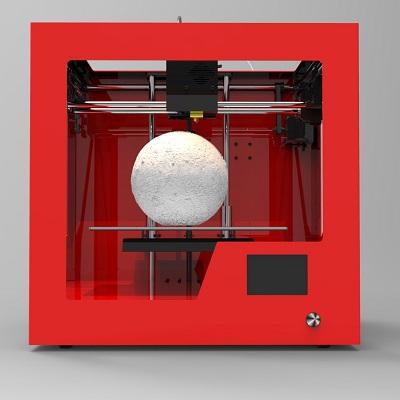FDM 3D Printer Widely Used for Prototyping and Concept Model Building

Fused Deposition Modeling builds concept models, functional prototypes and end-use parts in standard, engineering-grade and high-performance thermoplastics. It’s the only professional 3D printing technology that uses production-grade thermoplastics, so parts are unrivaled in mechanical, thermal and chemical strength.
How FDM Works
3D printers that run on FDM Technology build parts layer-by-layer by heating thermoplastic material to a semi-liquid state and extruding it according to computer-controlled paths. FDM uses two materials to execute a print job: modeling material, which constitutes the finished piece, and support material, which acts as scaffolding. Material filaments are fed from the 3D printer’s material bays to the print head, which moves in X and Y coordinates, depositing material to complete each layer before the base moves down the Z axis and the next layer begins.
Once the 3D printer is done building, the user breaks the support material away or dissolves it in detergent and water, and the part is ready to use.
Benefits of Fused Deposition Modeling
FDM is a clean, simple-to-use, office-friendly 3D printing process. Thermoplastic parts can endure exposure to heat, chemicals, humid or dry environments, and mechanical stress. Soluble support materials make it possible to produce complex geometries and cavities that would be difficult to build with traditional manufacturing methods.
Also it is a very affordable and economical 3D printing solution that does not costs too much. There are many types of products with different build sizes, printing precisions, and structure designs that can meet different requirements such as DIY, commercial and industrial uses. It is not only suitable for commercial and industrial manufacturing, but also suitable for personal DIY use.
Compared to traditional manufacturing technology, FDM greatly reduces the period of R&D process of a new product. Prototyping takes much less time and saves a lot of costs.
Applications of FDM Technology
Nowadays the mainstream 3D Printers in the market adopt FDM technology. Besides Plastic material, PC, wood, metal materials can also be used as filament that requires different extruding systems and nozzles. FDM technology can be widely used in the fields of manufacturing, education, medical, aerospace, industrial design, architectural, food and consumer goods and so on.
Shenzhen Inspiremaker Technology is professional 3D Printer R&D and manufacturer, who provide a variety of 3D printer and FDM 3D printer for commercial, industrial, education and DIY applications.
Advertise on APSense
This advertising space is available.
Post Your Ad Here
Post Your Ad Here

Comments